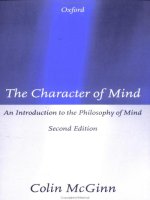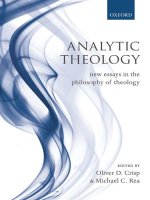- Trang chủ >>
- Khoa Học Tự Nhiên >>
- Vật lý
greed the seven deadly sins apr 2004
Bạn đang xem bản rút gọn của tài liệu. Xem và tải ngay bản đầy đủ của tài liệu tại đây (1.85 MB, 122 trang )
Greed:
The Seven Deadly Sins
Phyllis A. Tickle
OXFORD UNIVERSITY PRESS
Greed
Pride
Michael Eric Dyson
Envy
Joseph Epstein
Anger
Robert A. F. Thurman
Sloth
Wendy Wasserstein
Greed
Phyllis A. Tickle
Gluttony
Francine Prose
Lust
Simon Blackburn
For over a decade, The New York Public Library and Oxford
University Press have annually invited a prominent figure in the
arts and letters to give a series of lectures on a topic of his or her
choice. Subsequently these lectures become the basis of a book
jointly published by the Library and the Press. For 2002 and 2003
the two institutions asked seven noted writers, scholars, and
critics to offer a “meditation on temptation” on one of the seven
deadly sins. Greed by Phyllis Tickle is the fourth book from this
lecture series.
Previous books from The New York Public Library/Oxford
University Press Lectures are:
The Old World’s New World by C. Vann Woodward
Culture of Complaint: The Fraying of America by Robert Hughes
Witches and Jesuits: Shakespeare’s Macbeth by Garry Wills
Visions of the Future: The Distant Past, Yesterday, Today, Tomorrow
by Robert Heilbroner
Doing Documentary Work by Robert Coles
The Sun, the Genome, and the Internet by Freeman J. Dyson
The Look of Architecture by Witold Rybczynski
Visions of Utopia by Edward Rothstein, Herbert Muschamp,
and Martin E. Marty
Also by Phyllis A. Tickle
Eastertide—Prayers for Lent and Easter from The Divine Hours™
Wisdom in the Waiting
The Graces We Remember
A Stitch and a Prayer
What the Land Already Knows
Christmastide—Prayers for Advent Through Epiphany from The Divine Hours™
The Shaping of a Life
The Divine Hours™
God-Talk in America
In Good Company
Home Works
My Father’s Prayer
Re-Discovering the Sacred
Confessing Conscience
The Tickle Papers
Ordinary Time
Final Sanity
What the Heart Already Knows
Tobias and the Angels
On Beyond Koch
American Genesis
Figs and Fury
The Story of Two Johns
Greed
The Seven Deadly Sins
Phyllis A. Tickle
The New York Public Library
2004
Oxford New York
Auckland Bangkok Buenos Aires Cape Town Chennai
Dar es Salaam Delhi Hong Kong Istanbul Karachi Kolkata
Kuala Lumpur Madrid Melbourne Mexico City Mumbai Nairobi
São Paulo Shanghai Taipei Tokyo Toronto
Copyright © 2004 by Phyllis A. Tickle
Published by Oxford University Press, Inc.
198 Madison Avenue, New York, New York 10016
www.oup.com
Oxford is a registered trademark of Oxford University Press
All rights reserved. No part of this publication may be reproduced,
stored in a retrieval system, or transmitted, in any form or by any means,
electronic, mechanical, photocopying, recording, or otherwise,
without the prior permission of Oxford University Press.
Library of Congress Cataloging-in-Publication Data
Tickle, Phyllis A.
Greed : the seven deadly sins / Phyllis A. Tickle.
p. cm.
Includes bibliographical references and index.
ISBN 0-19-515660-9
1. Avarice—Religious aspects—Christianity.
I. Title. II. Series
BV4627.A8T53 2004 179'.8—dc21 2003048686 Rev.
Book design by planettheo.com
9 8 7 6 5 4 3 2 1
Printed in the United States of America
on acid-free paper
for Kate, D.C. and Brian, Wade, and Ben,
all newly come into this life.
May theirs be a time of holy imagination.
Mario Donizetti, Avarice, 1996, encaustic pastel.
Contents
EDITOR’S NOTE xi
PROLOGUE
Being a Bit of Context 1
THE ARGUMENT
Being a Study of Less Than Three Parts 17
EPILOGUE
Being Another Prologue 47
NOTES 53
BIBLIOGRAPHY 85
INDEX 89
This page intentionally left blank
Editor’s Note
This volume is part of a lecture and book series on the Seven
Deadly Sins cosponsored by The New York Public Library and
Oxford University Press. Our purpose was to invite scholars and
writers to chart the ways we have approached and understood evil,
one deadly sin at a time. Through both historical and contempo-
rary explorations, each writer finds the conceptual and practical
challenges that a deadly sin poses to spirituality, ethics, and
everyday life.
The notion of the Seven Deadly Sins did not originate in the
Bible. Sources identify early lists of transgressions classified in the
4th century by Evagrius of Pontus and then by John of Cassius.
In the 6th century, Gregory the Great formulated the traditional
seven. The sins were ranked by increasing severity, and judged to
be the greatest offenses to the soul and the root of all other sins.
As certain sins were subsumed into others and similar terms were
used interchangeably according to theological review, the list
evolved to include the seven as we know them: Pride, Greed, Lust,
Envy, Gluttony, Anger, and Sloth. To counter these violations,
Christian theologians classified the Seven Heavenly Virtues—the
cardinal: Prudence, Temperance, Justice, Fortitude, and the
xii EDITOR’S NOTE
theological: Faith, Hope, and Charity. The sins inspired medieval
and Renaissance writers including Chaucer, Dante, and Spenser,
who personified the seven in rich and memorable characters.
Depictions grew to include associated colors, animals, and
punishments in hell for the deadly offenses. Through history, the
famous list has emerged in theological and philosophical tracts,
psychology, politics, social criticism, popular culture, and art and
literature. Whether the deadly seven to you represent the most
common human foibles or more serious spiritual shortcomings,
they stir the imagination and evoke the inevitable question—
what is your deadly sin?
Our contemporary fascination with these age-old sins, our
struggle against or celebration of them, reveals as much about our
continued desire to define human nature as it does about our
divine aspirations. I hope that this book and its companions invite
the reader to indulge in a similar reflection on vice, virtue, the
spiritual, and the human.
Elda Rotor
Greed
This page intentionally left blank
PROLOGUE
Being a
Bit of Context
A religion editor for a trade journal—which is what I am and of
whom, believe me, there are not many—functions as a student of
religion commercially applied. From that perspective, religion is
most accurately seen as a rope or cable of meaning that stretches
through human history and has anchored, in one form or another,
every culture or subculture of human society from its beginning.
Like any good and anchoring cable, this one too is composed of
strands. In religion’s case, the strands are three in number: spiritu-
ality, corporeality, and morality. As components in a larger whole,
the three are held together by the porous, inner sleeve of a common
2 GREED
or shared imagination and then protected by an outer casing or
skin that we most commonly refer to as story.
Historically, the rope of meaning—of religion—will hold a
society or a people in place for decades, sometimes even
centuries, before some cultural shift or event causes a break or
unraveling in the story and a pocking of the imagination. When
that rupture of the protective casing and the insulating sleeve
occurs, inevitably the three working strands, which are always
discrete even as they are intertwined, are exposed to view. Once
that has happened, the effected culture must begin all over again
the business of lifting each strand separately up through the
sleeve and out of the cable, fingering and inspecting it to
satisfaction, and then returning it to a place in the braid of the
cable, though that new positioning is never quite identical to its
prior one. Eventually, once a culture is done with investigating
all three strands and has replaced them, the mesh sleeve is
smoothed back around their union, and the rip in the story is
knitted back together again. The cable is restored, good as new,
to its rightful duties for a while longer.
Every undergraduate can name with ease times when, the
casing having been stripped back and its lining pitted, our
forefathers have had to interpret, or mend, the story and weave
the inner sleeve in order to make the cable hold again. The
Babylonian Captivity was certainly such a time for Judaism, as
BEING A BIT OF CONTEXT 3
was the axial era for several faiths. More pivotal for most Euro-
Americans, of course, the Renaissance, the Reformation, and the
Enlightenment each challenged especially the Judeo-Christian
story and demanded that Western culture consider the strands of
the rope once more.
For contemporary readers, however, the peeling away of
religion’s story to expose religion’s constituent parts is not just a
matter of remembered or academically acquired history. It is also
very much one of lived experience—recently and presently lived
experience. During the twentieth century and especially during
its latter half, the West and most dramatically, America, passed
through—indeed, is still passing through the end of—a time as
rupturing, configuring, and informing for religion as was, for
instance, either the axial era or the Reformation.
1
From Albert Schweitzer’s first agonized cry of protest in
1906 that the Christ of history just might not be the Jesus of first
century Nazareth, to the descent of the Spirit upon the congre-
gations gathering on Azusa Street in Los Angeles that same year;
——from the founding and rampant success of Alcoholics
Anonymous in 1935 with its emphasis on self- or group-help and
its reverencing of a higher, but not doctrinally specific power, to
the archeology and caprices of fortune that would give us Nag
Hammadi and Qumran with their variant texts of, and variant
commentary upon, our accepted story;
4 GREED
——from the Second World War with its Holocaust horrors
that sent thousands of Europe’s brightest and most able Jews to
live in the United States as welcome agents of victory and thereafter
as appreciated and accepted fellow-citizens, to the change in 1965
of immigration laws that for the first time in decades allowed
people of Asian descent (people, we must note, who for centuries
had lived in the subjective and spiritual world as naturally as they
had lived in the objective one) to come among us less-lately-come
Americans, bringing with them their spiritual riches;
——from the discovery of antibiotics and the unprece-
dented advances in medicine’s ability to miraculously heal, to the
urbanization and mobility that ruptured the nuclear family;
——from the magnificent silence of the Big Bang and an
explored outer space, to the postulates of chaos physics;
——from the rise of radio and inexpensive publishing to the
establishment of the internet that enfranchised popular culture
and spawned the democratization of information.
From these and at least two dozen more equally dynamic
shifts and pivotal points in Western culture have come the
changed circumstances and perceptions that have unraveled and
slipped back both the cable’s casing and its lining, leaving
twentieth-century Western culture to finger its way through the
mesh and explore as it may the strands of meaning that had for
decades lain strong, but dormant, there.
2
BEING A BIT OF CONTEXT 5
As a people of many faiths and cultures but one polity,
Americans dealt first, during the last century, with spirituality.
As AA taught adult Americans more about the spiritual world
and as Buddhism and science showed us more and more about
how to map and traverse it, we began to gain a kind of comfort
and ease or, if you will, a surcease through familiarity. In time
the naivete of that position matured, and we began to stuff
spirituality back into its sustaining and rightful place in the cable.
As a result, it is now more appreciated among us than it was a
century ago, but it is also considerably less voguish than it was,
for instance, three decades ago.
The second strand, which we lifted out and began to inspect
in the last century, was corporeality, a bulky term that refers to
all the overt and institutionalized evidences of religion—its real
estate, clergy, administrative and professional hierarchies, insti-
tutions of learning and healing, canons, requirements of mem-
bership, legal status, budgets, etc. The last forty-odd years, from
Vatican II to today’s evening news, have been a veritable carnival
of medieval proportions in ecclesial adjustments and adjust-
ments, as most North Americans indeed know.
Ecumenism and shared communion, revised hymnals and
written prayer books, world and national and multinational coun-
cils, the ordination of women and lately of homosexuals, integra-
tion and apology, the interface of church and state and the proper
6 GREED
definitions thereof, the use of heavy endowments as political tools,
the use of ecclesial stature in international affairs, the usurping of
authority and power by laity, the rise of Pentecostalism—this list
too goes almost endlessly on, each member part of it telling the
story of a foment that is close to completing, in fact probably has
completed, the work of the Reformation and brought to its natural
end an era of 500 years of rampant divisiveness and sectarianism.
We are not done with our fingering of corporeality, of course; but
as with spirituality, we are already beginning to stuff wisps and
fibers of it back into place.
That leaves us with morality, the strand of religion that we
most dread and that our times are just beginning to lift out for
intense inspection. Indeed, we have so lately come to attending
the strand of morality that in all probability we have not even
shaped the subset of particulars that will become the questions of
our next quarter century.
Morality, because it effects and governs conduct, both
private and corporate, is the wiriest part of religion’s cable and
the one most susceptible to secularization. Thus, when morality
adulterates with schemes of action and values other than religion,
and especially when it slips its encasement in story and inter-
twines itself with them, it becomes something one may more
accurately call a code of conduct, or a system of values, rather
than of meaning; or to use the twentieth century’s term that first
BEING A BIT OF CONTEXT 7
heralded this shift in our times, it becomes an exercise in
“situational ethics.” That is to say that while all of these things
may indeed be matters of morality, they are to the degree of their
adulteration more political, philosophical, even utilitarian, to
borrow another old term, tools than they are religion.
Vietnam and hypnotic Americanism, like divorce, abortion,
and gender, may have been the opening battle cries of our new
engagement with morality as a strand of religion, but they were
as nothing compared to the questions that lie ahead. In partic-
ular, as science, medicine, theology, and philosophy probe ever
more skillfully into the nature of human mentation and subjec-
tive and/or spiritual structure, including into the evolution of
human consciousness, this culture will be faced with issues of
human responsibility and training and social management, even
of human manipulation, for which no prior intellectual guide-
lines exist and for which there is not yet a fully realized shared
imagination.
Most Americans realize that this tsunami is visible on the
horizon, whether we think about it every day with intention or
not; and most of us have held the questions attendant to it
consciously, if sotto voce, in our heads for at least two decades.
We have acknowledged their impending arrival enough even to
begin some of the initial work that will be required for our
survival as a civilization. We have come to imagine and some-
8 GREED
times admit, albeit tentatively, that even public morality must of
necessity have its roots in the private morality of its citizens. We
have begun once more to imagine that private morality is a
religious issue not only in theocratic states like ancient Israel or
much of contemporary Islam or pre-Reformation Europe but
also for the majority in democratic America. Here, while we may
not agree with one another religiously, we do believe, at a ratio
of nine to one, in adherence to some religious system. We also
seem to agree that if religion is not in and of itself the basis for
morality, it is nonetheless the litmus test for what morality can
and cannot include.
This train of thought, however subtle in its tracking, has
traveled slowly, but more directly than circuitously, to a grow-
ing, popular consideration of morality itself, to a consideration
not so much of what constitutes it, as to what causes violations
of it. At a popular level, the most arresting evidence of this
progression is the return of sin to the cultural conversation:
When, for instance, one sees pop music groups named “Sin” or
some play on words including it, when one sees phenomenally
popular games named “Sin,” when one sees website after website
focusing on sin, even when one sees smart and successful books
like Lyall Watson’s Dark Nature: A Natural History of Evil
3
or
John Portmann’s recent In Defense of Sin,
4
which are in content
exactly what their titles suggest.
BEING A BIT OF CONTEXT 9
When one sees these things and more, then the presence of
an increasing American preoccupation with sin as a concept is
as confirmed as it ever can be, short of some longitudinal study
that, so far as I know, never has been attempted nor ever could
be logistically feasible. I must observe, however, though just as
an aside, that the decision by Oxford University Press and the
New York Public Library to make the Seven Deadly Sins the
subjects in 2002 and 2003 for their jointly sponsored series of
lectures likewise offers its own kind of witness to an increasing
absorption with questions of evil.
5
I would also mention,
primarily because it is obvious and because I want to return to
it briefly elsewhere, that a preoccupation with sin during the
decades surrounding an era of apocalyptic anxiety is both
predictable and historically consistent, which does not mean to
suggest that our present and recent fixation upon it is any less
valid or real.
However we may document the increasing presence of sin
in our awareness, though, the fact is that any discussion of sin
leads, within minutes, if not seconds, to a discussion of the
reasons for it, the thinking behind it, the nature of its mecha-
nisms, even its possible uses. In that line of business, my own
tradition of Christianity has led the way, sometimes to levels of
fascination and intricacy that can only be called fatuous, if not
downright silly.









